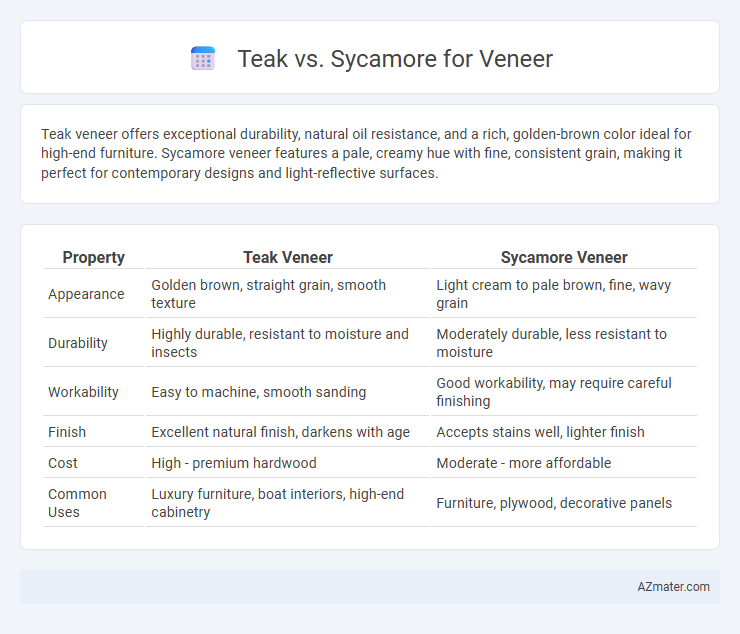Teak veneer offers exceptional durability, natural oil resistance, and a rich, golden-brown color ideal for high-end furniture. Sycamore veneer features a pale, creamy hue with fine, consistent grain, making it perfect for contemporary designs and light-reflective surfaces.
Table of Comparison
| Property | Teak Veneer | Sycamore Veneer |
|---|---|---|
| Appearance | Golden brown, straight grain, smooth texture | Light cream to pale brown, fine, wavy grain |
| Durability | Highly durable, resistant to moisture and insects | Moderately durable, less resistant to moisture |
| Workability | Easy to machine, smooth sanding | Good workability, may require careful finishing |
| Finish | Excellent natural finish, darkens with age | Accepts stains well, lighter finish |
| Cost | High - premium hardwood | Moderate - more affordable |
| Common Uses | Luxury furniture, boat interiors, high-end cabinetry | Furniture, plywood, decorative panels |
Introduction to Teak and Sycamore Veneer
Teak veneer is prized for its durability, water resistance, and warm golden-brown hues with straight grain patterns, making it ideal for high-end furniture and cabinetry. Sycamore veneer features a pale cream color with a fine, even texture and subtle grain, offering a light and elegant appearance suited for decorative paneling and interior finishes. Both veneers provide distinct aesthetic and functional qualities, with teak favored for strength and longevity, while sycamore is chosen for its smooth, clean look.
Botanical Origins and Characteristics
Teak (Tectona grandis) originates from Southeast Asia and is renowned for its high oil content, durability, and rich golden-brown hue that darkens with age, making it prized for veneer in luxury furniture. Sycamore (Acer pseudoplatanus), native to Europe and Western Asia, features a pale, creamy color with subtle, wavy grain patterns and a fine, uniform texture ideal for light-toned veneers. Botanical characteristics such as teak's dense hardwood fibers and natural resistance to pests contrast with sycamore's softer, more workable wood prized for intricate patterns, influencing their respective applications in veneer production.
Aesthetic Differences: Color, Grain, and Texture
Teak veneer features a warm golden-brown color with rich, straight grain patterns and a smooth, oil-rich texture that enhances its natural luster. Sycamore veneer offers a lighter, cream to pale brown hue with subtle, fine grain and a smooth, slightly porous texture creating a softer, more understated appearance. The contrasting color tones and grain complexities make teak ideal for luxurious, bold designs, while sycamore suits delicate, contemporary aesthetics.
Durability and Structural Strength
Teak veneer offers superior durability due to its natural oils, providing resistance against moisture, termites, and decay, making it ideal for high-wear applications. Sycamore veneer, while aesthetically pleasing with a fine, even grain, has moderate durability and is more prone to damage from impact and moisture exposure. Structurally, teak is stronger and more stable under varying environmental conditions, whereas sycamore requires careful handling and maintenance to preserve its integrity in veneer use.
Workability and Machining Properties
Teak veneer offers excellent workability due to its medium density and natural oils that reduce wear on cutting tools, making it suitable for intricate machining and fine detailing. Sycamore veneer, being lighter and more uniform in texture, machines smoothly with minimal tool resistance but requires careful handling to prevent chipping or tear-out during precise cuts. Both veneers perform well in veneering applications, though teak's durability and natural oils provide superior resistance to machining wear compared to sycamore.
Environmental Sustainability and Sourcing
Teak veneer, prized for its durability and natural oils, originates primarily from Southeast Asian plantations, where sustainable forestry certifications like FSC ensure responsible harvesting practices that protect biodiversity. Sycamore veneer, sourced mainly from North American hardwood forests, benefits from faster growth rates and widespread availability, allowing for more efficient regeneration and reduced environmental impact when managed under sustainable forestry programs. Both veneers offer eco-friendly options when sourced from certified suppliers, but sycamore's rapid renewability and lower ecological footprint often make it a more sustainable choice for environmentally conscious applications.
Cost Comparison and Market Availability
Teak veneer typically commands a higher price due to its durability, rich grain, and natural oils that resist moisture and insects, making it a premium choice in flooring and furniture markets. Sycamore veneer is generally more affordable and widely available, offering a light, consistent grain pattern favored for contemporary and mass-produced designs. Market availability for teak is limited and often seasonal due to sustainable harvesting restrictions, whereas sycamore is readily sourced from temperate regions, ensuring steady supply and lower lead times.
Common Applications in Interior Design
Teak veneer is prized in interior design for its durability, rich golden-brown hues, and natural resistance to moisture, making it ideal for high-end furniture, cabinetry, and luxurious paneling. Sycamore veneer offers a lighter, creamy tone with intricate grain patterns, preferred for contemporary furniture, decorative wall panels, and custom millwork where a bright, airy aesthetic is desired. Both veneers are widely used in residential and commercial interiors, but teak excels in spaces requiring robust wear resistance while sycamore enhances areas emphasizing visual texture and light-reflective qualities.
Maintenance and Longevity of Veneered Surfaces
Teak veneer offers superior durability and low maintenance due to its high natural oil content, which resists moisture and insect damage, making it ideal for long-lasting surfaces. Sycamore veneer, while visually appealing, requires more frequent sealing and careful upkeep to prevent warping and surface wear over time. Choosing teak veneer ensures enhanced longevity and reduced maintenance efforts compared to sycamore in high-use applications.
Choosing the Right Veneer: Key Considerations
Teak veneer offers exceptional durability and water resistance, making it ideal for furniture exposed to moisture, while sycamore veneer provides a smooth, pale finish suited for modern and minimalist designs. Consider factors such as grain pattern, hardness, and cost; teak has a rich, oily texture with a higher price point, whereas sycamore is softer and more affordable but less resistant to wear. Weight and environmental impact also influence the choice, with teak being denser and often sourced sustainably, whereas sycamore grows faster but may require more finishing for durability.

Infographic: Teak vs Sycamore for Veneer
 azmater.com
azmater.com